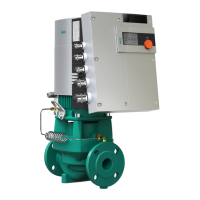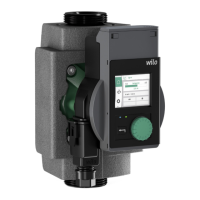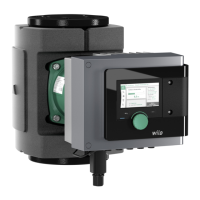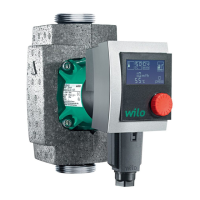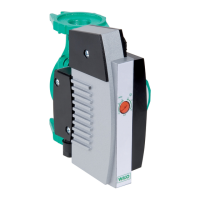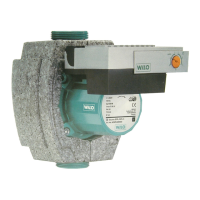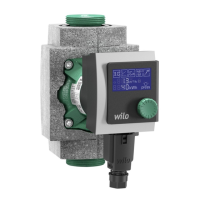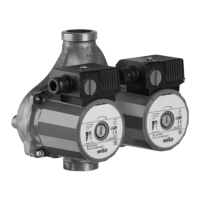Do you have a question about the Wilo Stratos-D Series and is the answer not in the manual?
| Application | Heating |
|---|---|
| Connection Type | Flange connection |
| Fluid Temperature Range | -10 °C to +120 °C |
| EEI | ≤ 0.20 |
| Display | LCD |
| Power Consumption | Varies depending on model |
| Housing Material | Cast iron |
| Motor Type | EC motor |
| Energy Efficiency Class | A |
Details the document's origin, purpose, and adherence requirements.
Provides information on the product's compliance with EC directives.
Explains safety symbols, signal words, and their meanings.
Specifies the required qualifications for installation, operation, and maintenance personnel.
Outlines risks of injury, environmental damage, and loss of claims from non-compliance.
Emphasizes adherence to regulations and internal safety rules.
Lists safety precautions for the operator, including child supervision and component handling.
Details safety measures for installation and maintenance work, including standstill procedures.
Warns against modifications and stresses the use of original spare parts for safety.
Highlights that operating safety is guaranteed only for conventional use within specified limits.
Advises checking for transit damage and protecting the pump from environmental factors.
Specifies applications for high-efficiency pumps, excluding potable water for some models.
Explains the coding system used to identify pump models and specifications.
Provides detailed technical specifications like voltage, frequency, current, and temperature limits.
Lists the items included in the pump's package.
Mentions optional accessories like IF Modules and IR units that must be ordered separately.
Describes the glandless pumps with integrated control and ECM technology.
Explains the control module's role in managing differential pressure and pump adaptation.
Differentiates between "Heating" and "Cooling/air-conditioning" modes based on fault handling.
Details modes like Ap-v, Ap-c, and Ap-T for controlling differential pressure based on flow or temperature.
Covers manual control and "auto" modes for optimizing energy consumption and reducing costs.
Describes overload protection, data storage, pump kick, and SSM signal functions.
Explains master/slave, main/standby, and efficiency-optimised peak-load operations for double pumps.
Defines various symbols shown on the pump's LC display for status and control.
Provides general safety and installation guidelines, including indoor and outdoor considerations.
Details the process of installing pumps with threaded pipe unions.
Covers the installation of pumps with PN6/10 and PN10/16 flanges, including torque specifications.
Explains how to fit thermal insulation shells for heating applications.
Advises using diffusion-proof materials for cooling systems and ensuring proper condensate drainage.
Outlines crucial safety instructions and requirements for connecting the pump to the power supply.
Describes the process of filling and venting the pump and system to prevent noise.
Guides users through the menu structure for initial setup and parameter adjustment.
Explains how to navigate menus and change settings using the control button.
Details how to adjust the display orientation for horizontal or vertical installation.
Illustrates the sequence of menus for single pump operation and parameter adjustments.
Provides guidance on choosing the appropriate control mode (Ap-v, Ap-c, Ap-T, Manual, Setback) based on system type and conditions.
Explains how to set the pump's duty point on the maximum curve or within the control range.
Covers operational aspects, including electromagnetic field interference and its effects.
Provides safety warnings and procedures for dismantling and installing the pump, including magnetic field hazards.
Details the steps for removing and refitting the control module, emphasizing safety.
Lists faults occurring in HV mode, their causes, and remedies, including auto-restart behaviour.
Details faults in AC mode, their causes, and remedies, noting immediate deactivation for certain codes.
Lists warning signals, their causes, and remedies, noting that the pump continues running.
Instructs on how to order spare parts, requiring name plate data.
Advises on proper disposal methods and recycling information, prohibiting household waste disposal.

